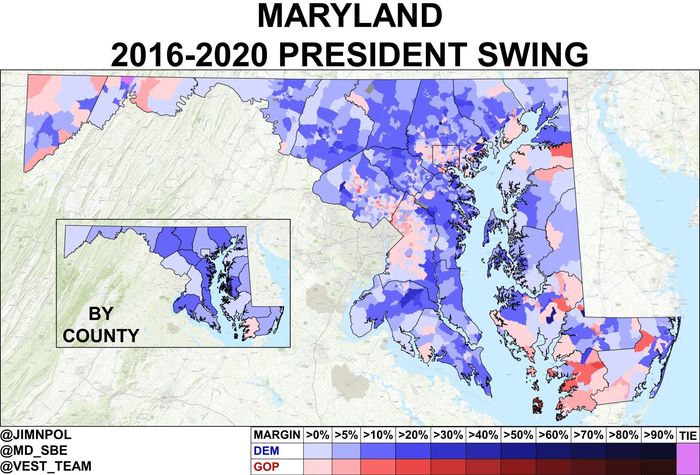The Eastern Shore is Bluer Than You Think
The Eastern Shore of Maryland is much bluer than you think, and a proper investment in local organizations like the Lower Shore Progressive Caucus can yield big wins for the party and movement at the local, state, and federal levels.
The 2020 presidential election was historic in many ways, especially after the four-year nightmare of Donald Trump. However, one of the biggest pieces of history has been swept under the rug, and that is the fact that Joe Biden’s election signifies the first time a Delmarva citizen has held executive office at the federal level.
That change is a major milestone for this area and shows that as a region, we are a lot bluer than generally recognized. The Biden-Harris ticket won several counties on the Delmarva peninsula, including Northampton, New Castle, Kent in Delaware, Kent in Maryland, and Talbot. Biden also came within 860 votes of winning in Wicomico County, the best result for a Democrat running for president in the county since 1996.
The Lower Shore Progressive Caucus helped in the effort to elect Joe Biden. Our organization’s local effort focused on contacting voters on the Lower Eastern Shore, texting and phone banking local voters to build support for our locally endorsed progressive candidates and to remind them to vote. These efforts directly contributed to the massive turnout we saw on November 3. More importantly, it expanded the leftward trend on the Lower Shore over the last few cycles.
It has been said for decades that the Eastern Shore is an impenetrable red wall that cannot be won by Democrats, let alone progressive Democrats. However, the Shore is much more than a highway and some fields between the Western Shore and Ocean City and Assateague. It is a region that with the proper investment and care put into it can yield big results for the Democratic Party and progressive movement.
The Eastern Shore’s Democratic trend started in the 2008 presidential election, when Kent County voted for President Obama. The following cycle in 2010 saw more gains for Democrats as Sen. Barbara Mikulski won a commanding five of nine Eastern Shore counties. Mikulski’s performance on the Shore showed that when Democrats invest the resources and manpower needed to be competitive, they can win.
Mikulski wasn’t the only Democrat to perform well here, either. In 2018, Sen. Ben Cardin heavily invested on the Eastern Shore and won four of the nine counties.
When it comes to investing and campaigning on the Shore, nobody has done it better than Maryland Comptroller Peter Franchot. For years, Franchot has made frequent visits to the Shore and has built up his name recognition and a broad base of support across the political spectrum and within every demographic.
His hard work paid off in 2018, when he won eight of nine counties by over 15 percent of the vote. A landslide victory on the Eastern shore by a Democrat is something not been seen in many decades, and shows that when a candidate makes an effort here, they can win.
Election recaps aside, I’m sure you are probably wondering, “OK, so how do these results show that progressive policies and candidates can win here on the Shore?”
In down-ballot races, the Lower Shore Progressive Caucus has worked hard to help elect 12 progressives on the Lower Shore in just three cycles. We were also able to help turn out the vote for the Biden-Harris ticket and have vastly increased Democratic turnout by highlighting the more progressive aspects of the Democratic Party’s platform. Progressive policies such as the “Fight For 15,” marijuana legalization, environmental protection, green energy initiatives, and guaranteed universal health care via “Medicare for All” are not only popular policies, but also a winning message here.
For decades, resources and manpower have been taken away from the Eastern Shore and sent to other races that are either solid blue or out-of-state. This divestment has caused the Republican Party to gain the upper hand in many communities and left Democrats organizing on the bare minimum. The effects of this are shown by the election of right-wing radicals such as Andy Harris, Mary Beth Carroza, and Nicole Acle. For us on the Shore to continue to build on the successes of 2020 and our down-ballot wins, we need sustained investment to ensure we can afford what we need to compete across the board in 2022.
To learn more about the Lower Shore Progressive Caucus, go to https://www.lowershoreprogressives.com/
Jared Shablein is the Chair of the Lower Shore Progressive Caucus.
Common Sense for the Eastern Shore











